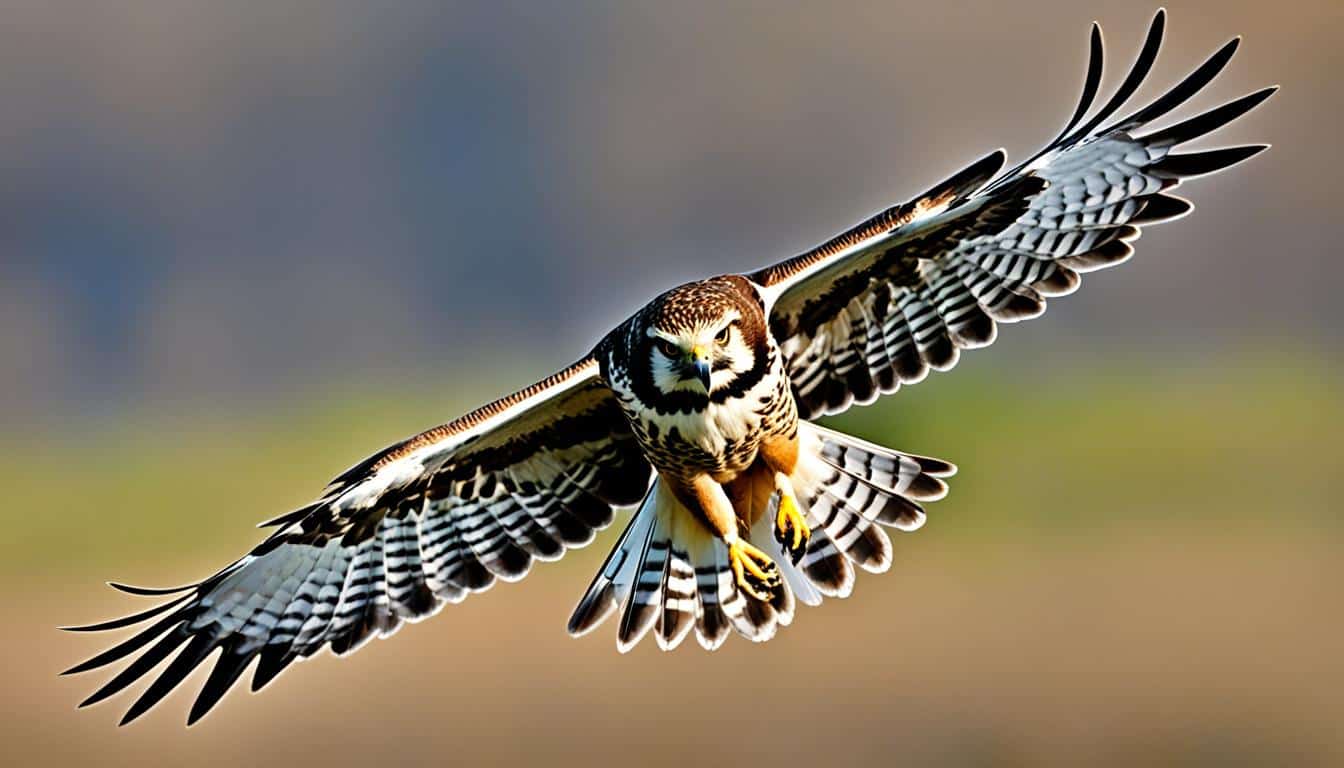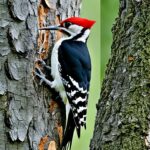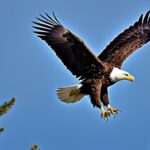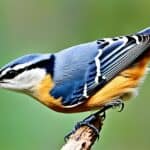Identifying hawks is a thrilling part of birding. It needs a sharp eye and attention to details.
Birders got really excited at a festival in Cape May. This was when they saw a Swainson’s hawk. Events like this show how tricky it can be to tell hawks apart. For example, the sharp-shinned and Cooper’s hawks look very similar. But details like wing shape, tail form, and how they fly help. Unique marks, like the white rump patch on the Northern harrier, are also key.
Understanding Hawk Identification Basics
Identifying hawks involves looking closely at unique characteristics. Whether it’s the colors and sizes or the changes between young and adult hawks, these details matter. Observing different hawk kinds helps in identifying the species correctly.
If it’s tricky to spot hawks by their looks, we can use where they are, how they fly, and their sounds. Knowing which hawks visit an area at certain times can help. For instance, understanding their seasonal patterns can guide you to the right species.
- Plumage and Size Accuracy: Look at the bird’s colors and patterns closely.
- Geographical Range Efficiency: Know where these birds tend to be.
- Flight Type Observation: Pay attention to how they fly.
- Vocalization Analysis: Listen for their unique calls.
Learning about the main hawk groups and what makes them different is key. This basic understanding paves the way for better identifications. Every hawk identification tip helps in spotting different hawk subspecies. This makes bird watching informative and fun.
Hawk Families in the USA
Hawk families are diverse across North America. Each has its own unique surroundings and habits. Knowing about the main groups of hawks will help you spot these amazing birds outdoors.
Accipiters
Accipiters, such as sharp-shinned and Cooper’s hawks, live in wooded areas. They have fast, agile flights and use their long tails and short wings to navigate tight spots. These hawks feed on small birds and fly skillfully through forests.
Buteos
Red-tailed and red-shouldered hawks are among the Buteos. They can be found sitting in open fields or on poles looking for food. Buteo hawks are known for their wide wings and solid bodies. You’ll often see them soaring high, searching for prey below.
Falcons
Species like the peregrine falcon are known for their speed and sharp turns. Falcons have a unique notch on their beak that helps them catch other birds. They’re amazing at catching airborne prey and are the best divers among hawks.
Ospreys
Ospreys stand out because they mainly eat fish. They’re great at catching fish from the water with their sharp claws. You can spot an osprey by its black eye stripe and hooked beak.
Harriers
The northern harrier stands out with its unique flight and white rump patch. These hawks are often found flying low over fields and marshes, looking for rodents and smaller birds. They have a facial disk like an owl, which helps them hunt using their keen sense of hearing.
| Hawk Family | Common Species | Key Features | Primary Habitat |
|---|---|---|---|
| Accipiters | Sharp-shinned Hawk, Cooper’s Hawk, Northern Goshawk | Short, rounded wings; long tail | Woodlands |
| Buteos | Red-tailed Hawk, Red-shouldered Hawk | Broad wings; stout body | Open areas, woodlands |
| Falcons | Peregrine Falcon, American Kestrel | Pointed wings; tomial tooth | Various, often open areas |
| Ospreys | Osprey | Hooked beak; black eye stripe | Near water bodies |
| Harriers | Northern Harrier | White rump patch; owl-like face | Open fields, marshes |
How do you distinguish between different types of hawks in the USA?
Distinguishing hawks in the USA means looking at their wings, tails, and how they fly. By noticing these features, you can make your bird watching more exciting.
Hawks with short, rounded wings and long tails are likely Accipiters. Those with broad wings and short tails, like the red-tailed hawk, are probably Buteos. Falcons have long, pointed wings for fast flying.
Understanding how hawks fly is also key. Cooper’s hawks move quickly, then glide. Red-shouldered hawks flap slowly and soar. These flying styles help with identification from far away.
Knowing where hawks live is important too. Accipiters live in woods, while buteos prefer open fields and roads. This knowledge can guide you on where to look for hawks.
With these tips, you’ll be better at spotting and telling hawks apart in the USA. It doesn’t matter if you’re new or experienced. These details make bird watching more enjoyable and educational.
Key Characteristics for Hawk Identification
Identifying hawks can be both fun and rewarding. Look at their wing shape, tail shape, and how they fly. By focusing on these features, it’s easier to tell hawks apart in nature.
Wing Shape
Wings are key for hawk identification in flight. Accipiters have wings that are either rounded or pointed. This helps them move quickly in forests. Buteos have broad and straight wings for easy soaring above open spaces. Falcons’ tapered wings are perfect for their speedy, acrobatic flights.
Tail Shape and Length
Identifying hawks by wings and tail is all about tail shapes and sizes. Buteos have shorter tails. In contrast, accipiters have longer tails. This makes them more agile. Spotting these tail differences is important, whether they’re flying or resting.
Flight Patterns
Bird wings and flight feathers greatly affect hawk flight styles. Accipiters have a unique “flap-flap-glide” pattern. Buteos fly more steadily and can often be seen circling above. The Cooper’s hawk stands out with its special flying pose. Knowing these flight behaviors helps with hawk identification.
Common Accipiters in the USA
Hawks from the Accipiter genus are found all over North America. They each have special traits that make them stand out. This includes the Sharp-shinned Hawk, Cooper’s Hawk, and Northern Goshawk. Knowing what makes them different helps when you try to spot them.
Sharp-shinned Hawk
The Sharp-shinned Hawk is the littlest in its group and loves zooming through forests. To spot a Sharp-shinned Hawk, look for their small, rounded wings and a slim, banded tail. They flutter their wings quickly and make a sound like kik-kik-kik. This unique call can help you find them in the trees.
Cooper’s Hawk
Cooper’s Hawks are bigger than the Sharp-shinned. They can live in all sorts of places, from woods to cities. You can recognize them by the cap-like mark on their heads, long wings, and rounded tail end. They fly with a strong, steady rhythm. Keep an ear out for their distinctive cak-cak-cak sound when searching.
Northern Goshawk
The Northern Goshawk is the biggest of all the Accipiters. It has a bulky body, a strong build, and a white stripe above its eye. They move with slow, powerful wingbeats in a straight line. Minding their unique calls can make finding them really exciting. Their grand size and way of flying are always a special sight in birdwatching.
| Hawk Species | Size | Flight Pattern | Call |
|---|---|---|---|
| Sharp-shinned Hawk | Smallest | Quick, choppy wingbeats | kik-kik-kik |
| Cooper’s Hawk | Midsize | Firm, deliberate | cak-cak-cak |
| Northern Goshawk | Largest | Slow, powerful wingbeats | Distinct patterned call |
Common Buteos in the USA
Exploring hawks in the USA means knowing common buteos. Each type has special traits, ways, and homes.
Red-tailed Hawk
The Red-tailed Hawk is everywhere in North America. It’s known for its red tail. You’ll spot it in places like fields and deserts. Look for its wide wings and strong body.
Red-shouldered Hawk
Spot the Red-shouldered Hawk by its rusty shoulders. It makes loud sounds like piercing whistles. They live in forests where their color helps them hide.
Rough-legged Hawk
The Rough-legged Hawk likes cold areas and has feathered legs. In winter, it hovers to hunt. It visits the USA during cold months, so it’s a special sight.
| Buteo Species | Key Identification Features | Preferred Habitat |
|---|---|---|
| Red-tailed Hawk | Reddish tail, broad wings | Open fields, deserts |
| Red-shouldered Hawk | Rusty shoulders, loud whistles | Woodlands |
| Rough-legged Hawk | Feathered legs, hovering flight | Winter territories |
Other Notable Hawk Species
Identifying hawks can be tricky, but knowing the features of special ones is rewarding. Species like the Harris’s Hawk, Zone-tailed Hawk, and Common Black Hawk stand out.
Harris’s Hawk
Harris’s Hawks stand out with their striking reddish-brown patches. They are known for hunting in groups, which is not common among hawks.
You can usually find them in desert areas. Their long legs and wide wings make them look unique. This makes spotting a Harris’s Hawk simple.
Zone-tailed Hawk
Few in number, Zone-tailed Hawks are interesting to watch. They fly high above forested areas next to streams. At first glance, they might be mistaken for turkey vultures due to their looks.
However, their black feathers and white tail bands are key signs to tell them apart. This unique trait is how you know you’re looking at a Zone-tailed Hawk.
Common Black Hawk
The Common Black Hawk often lives near water, like in marshes or by rivers. It’s distinguished by a broad, white band across its tail. Their strong build and love for watery environments make them easy to spot.
| Species | Key Traits | Habitat |
|---|---|---|
| Harris’s Hawk | Reddish-brown patches, cooperative hunting | Desert lowlands |
| Zone-tailed Hawk | Black plumage with white tail bands | Wooded streams |
| Common Black Hawk | Broad white tail band | Near water (marshes, rivers) |
Hawk Habitat and Range
Hawks live in many places across the USA. They can be found in thick forests or wide open spaces. Knowing where to look helps identify the type of hawk you see.
Take the Northern Harrier, for example. It often flies over fields and marshes. On the other hand, the Red-tailed Hawk likes to sit along roads and in the open. It’s essential to understand different habitats for spotting hawks correctly.
Their areas of living vary greatly. For instance, the Ferruginous Hawk loves open dry lands. You’ll find it mainly in the western US. But, the Red-shouldered Hawk likes the eastern US more, living in forests and wet areas.
- Sharp-shinned Hawks prefer dense forests, especially where there are many evergreens.
- Swainson’s Hawks take long journeys, flying from North America to Argentina. They like open grasslands when it’s time to nest.
- Cooper’s Hawks do well in towns, often spotted in areas with lots of trees.
Looking at a hawk’s actions can help figure out where it lives. For example, Red-tailed Hawks often sit in obvious places. Harriers, on the other hand, fly low over fields as they hunt.
The time of year can also change where hawks are found. Rough-legged Hawks move from the far north to the lower 48 states in winter. Watching these seasonal patterns teaches us more about different hawks.
“To be great at spotting hawks, you need to know more than just how they look. It’s also about their favorite places and how they move around.”
Using Vocalizations for Identification
Identifying hawk calls is key for bird lovers. It helps us mark which hawk species is nearby by the sounds they make. Knowing the unique noises hawks make adds to the excitement of spotting them.

Calls of Accipiters
Each hawk type has its own call. Take the Cooper’s Hawk, for instance, it makes a steady cak-cak-cak sound. Then, we have the Sharp-shinned Hawk whose call is a high kik-kik-kik. When in a wooded area, these sounds guide you to the right hawk.
Calls of Buteos
The Red-tailed Hawk stands out with its loud kee-eeeee-arr. It’s a notable feature of North America’s wild sounds. This call is a big help when looking to spot one of these hawks with broad wings.
Calls of Falcons
Falcons have quite different sounds. The Peregrine Falcon, for example, has fast kak-kak-kak calls. Often, you’ll hear these in cities around tall buildings. These sounds point to the presence of these agile hunters.
Final Tips for Hawk Identification
Learning about hawks in the USA takes heart, keen eyes, and patience. You should get to know key traits of hawk families. These include the shapes of their wings and tails, which can help you start narrowing down species. For example, accipiters have narrow, rounded wings and long tails. But, buteos sport broader wings and shorter tails.
It’s also crucial to recognize how hawks fly. Accipiters like the Cooper’s Hawk move swiftly and with agility. Meanwhile, buteos like the Red-tailed Hawk soar in a more leisurely way. Also, specific markings, like the white rump of the Northern Harrier, or the Red-shouldere Hawk’s rusty shoulders, can give clues.
Listening to hawk sounds is the final tip. For instance, a high kik-kik-kik means the Sharp-shinned Hawk is near. On the other hand, the Red-tailed Hawk is known for its sharp scream. Getting to know hawk calls is vital for spotting them when they’re hard to see. When you combine these sound and sight tips, you’ll enjoy identifying hawks even more.
FAQ
How do you distinguish between different types of hawks in the USA?
Distinguishing between different hawks involves looking at wing and tail shapes, flight patterns, and feathers. Characteristics like a white rump patch or wing shape help tell them apart. It’s also important to know where they live, how they act, and what they sound like.
What are some key tips for hawk identification?
For identifying hawks, pay attention to their wings, tails, and how they fly. You can also look at where they are found and what they do. For instance, some hawks like to hunt in big open spaces, while others are quick in the woods.
What are the main families of hawks in the USA?
In the USA, you can find hawks from five main families: Accipiters, Buteos, Falcons, Ospreys, and Harriers. They each have their own special traits. For example, Sharp-shinned Hawks and Northern Goshawks love the woods, while Red-tailed Hawks soar in the open.
How can I identify a Sharp-shinned Hawk?
The Sharp-shinned Hawk is the smallest of its family. You can spot it by its size, how it flies in the wind, and its “kik-kik-kik” call. It often lives in wooded areas and has wings that are either rounded or pointed.
What are the identifying features of a Red-tailed Hawk?
To find a Red-tailed Hawk, look for its red tail and its love for wide open spaces. It’s a major Buteo in North America. When it cries, it makes a loud “keeeeer” sound that is very hawk-like.
What distinguishes a Harris’s Hawk from other hawks?
The Harris’s Hawk stands out with its red-brown marks and how it hunts together, unlike many hawks. You’ll generally find it in desert lowlands, where it makes its unique call. It also has a notable pattern on its tail.
How do vocalizations aid in hawk identification?
Hearing a hawk’s call is a big help in figuring out what kind it is. Varieties like the Cooper’s and Sharp-shinned Hawks have their own unique calls. The Red-tailed Hawk, on the other hand, has a scream that’s famous and helps a lot when you can’t see them.







